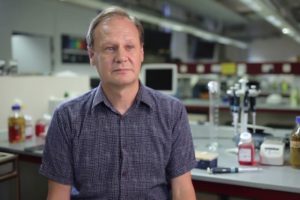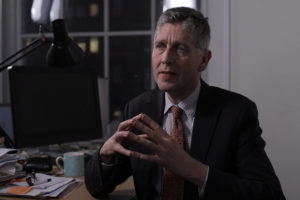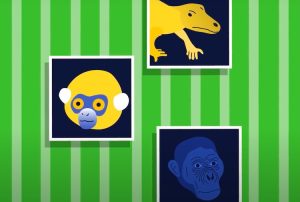Innate Immunity
Molecular biologist Greg Towers on interferons, uninfectable cells, and how breaking a virus can actually help...
How is it possible that mitochondria have their own DNA? What does it mean that we are mishmash of two species living together? Professor of Genetics at Harvard Medical School David Sinclair speaks on rejuvenation experiments.
So, one of the big questions in biology is, “Why don’t we live forever?” Maybe one day we will. But until we understand why we grow old and get diseases such as Alzheimer’s, diabetes, cancer, and cardiovascular disease, we will not have a chance to greatly extend our lifespan. One of the main reasons for this is that we currently address one disease at a time, and even though we have breakthroughs in cardiovascular disease, other diseases, such as Alzheimer’s, are rather recalcitrant and very difficult right now to prevent and cure. And, so, what happens is that we have the decline in one disease, and then another disease accelerates in its frequency.
So mitochondria are critical for life; we know that. In fact, if you poisoned the mitochondria, say, with cyanide, you’ll be dead within about 30 secs. So we really need to understand not just how mitochondria function but how to keep them healthy throughout our life. And one of the main theories of aging is that over time—well, we start out young, and there are lots of mitochondria, and they are healthy, and they know how to function and make lots of energy, and we feel great, we have got energy, we can run, we can fight off diseases; our brain functions well, we can remember, and we do not get diabetes, we do not have dysfunctional muscles, for example. But over time, let’s say, people like me, who are now in midlife, are starting to lose their mitochondrial function – that is a fact. And then, by the time we are in our 60s and 70s, it’s even worse. And then, till 90, we will have much, much lower mitochondria functioning, and they will have less ATP. This is a problem.
We, scientists, think that one of the major causes of diseases during aging is caused by this loss of the ability of our cells to make energy.
Now, as I have mentioned, mitochondria are free-living organisms in our cells. They joined our cells about 2 billion years ago. They were what was called alphaproteobacteria. We find these free-living bacteria right now, umm, in the world, but they are genetically related and functionally related to our mitochondria. And what is important is that these mitochondria have their own DNA. They brought their own genome with them when they joined our cells to make eukaryotes. And today, they still have many of those genes in their genome. The other genes that used to be in that genome – it’s a circular genome – has been transferred to the nucleus. And so, we are really just a mishmash of two species living together, and the genomes exist separately, but they need to communicate very well together to maintain their co-existence and be healthy. And later, I will tell you that one of the problems with aging might be that these two genomes within our cells lose the ability to communicate.
But first, I wanna tell you about an older theory of aging that still holds some way, what was what I am to think this is more of a later stage of aging. So back in the 1940s and 1950s, I was telling you that the mitochondrial theory of aging was born. And that was the idea that during metabolism, there are a lot of free radicals – or we call these reactive oxygen species that can damage macromolecules. The idea is as the mitochondria, when they are young, are functioning, they are producing these free radicals that damage the enzymes and particularly the DNA within the mitochondria. And over time, we start to lose the code that’s in our mitochondrial DNA. We get mutations; we get big deletions. So, e.g., if we took my DNA from pretty much any cell except perhaps the germ cells in my testis, these cells would have a large number of mutations and deletions already, which is rather disturbing. And the idea is if we could slow down this damage to our DNA, we would have a way to delay aging. We could prevent these mutations, and we would actually be healthy into long and have a longer life.
Now what carries out this communication is that: so we have the nucleus here and the mitochondria here. Their proteins are made in the nucleus by our main chromosomes, and those proteins travel across the cytoplasm into the mitochondria, and they help mitochondria be healthy; they make it make just the right amount of energy to match what the cell needs. What we found is that during aging in the early stages of this communication, these proteins that move across from the nucleus to mitochondria start to lose their activity. You do not have as much made anymore in the cells.
Now the good news is that if we could restore that communication:
We might have a chance of reversing aspects of aging if we catch it early enough.
Now the analogy that I like to make is that the nucleus and the mitochondrial genomes, these two genomes are like a married couple: when they move in together early, they’re in love, they communicate well, they talk, they share ideas, and that’s what our cells are like when they were young. But over time, they don’t talk as much; they develop different interests, and they stop talking over time. And we know that that’s the worst thing that can happen for marriage, and we think the same thing happens for the marriage of these two organisms, these two genomes in our cells. And our job now is to test what happens if you can restore that communication again and get them talking again.
And just in December of 2013, our lab published an interesting paper that showed the following: it showed that one of the main causes of miscommunication is that the nucleus does not think it is getting enough energy anymore, and it does not send signals to the mitochondria to make them produce the energy anymore. We track this down to the loss over a small molecule called NAD.
We think NAD is critical for cells’ health and their ability to maintain this healthy communication. So what we did was we simply raised the NAD levels back up in a mouse to the youthful levels. So a mouse, when it is young, has, let’s say, this amount of NAD, and over time NAD levels drop by half. What we found: well, first of all, we asked a question: if we raise these levels back up to youthful levels of NAD, what happens? Can we restore this communication? We did that. The way you do that is actually quite simple: you inject a mouse with the molecule that this animal turns into NAD. You can buy this from a chemical company, you inject it for a week, and we ask: does this have a benefit in restoring communication? And the answer was – yes. Now after one week of raising NAD, the nucleus was reestablishing communications with the mitochondria, and they were talking again.
And then we could ask: does this improve health? Does it restore the energy of the cell, which we think is a cause of aging? And the answer was, quite remarkably – yes. The mice, when we looked at their muscle and the heart, they had a restoration of youth, the mitochondria were revved up again after just a week, and they were making energy and, as far as we could tell looking at all these functional assays of the mitochondrial activity, their ability to make energy, their genome’s activity, the amount DNA they had – they went straight back to being young again. So we actually couldn’t tell the difference between a two-year-old mouse and a six-month-old mouse. What that really is like is saying, ‘we could take a 50-60-year-old human muscle and make it like a 30-year-old again’.
Now I meant that it would be great if it’s true in humans. We only know in mice so far, but we are gearing up to test this in humans. We think that if we could give this molecule that raises NAD in a pill or an injection, we think that within a week, if we’re right, then we could reverse aspects of aging in humans, and that would be something really quite spectacular. And if we can do that, there’s a possibility that we could actually not just see people get old and experience diseases and slow down one disease at a time with traditional medicines. If we catch this effect early, we could reverse mitochondrial aging. And if everything turns out to be correct, then what we expect is that humans will not develop diabetes, even cancer, heart disease, or Alzheimer’s until much later, maybe into the nineties, hundreds, or further. And so we’re looking at a future where we might be able to restore youthful energetics in cells, prevent mitochondrial aging, keep this organism within our bodies healthy, and live much longer, healthier lives.

Molecular biologist Greg Towers on interferons, uninfectable cells, and how breaking a virus can actually help...

Cognitive neuroscientist Patrick Haggard on the Pacinian corpuscle, three attributes of the tactile sensations...

Recently found pre-enzymes give answers to the mystery of ancient amino acids assembling spontaneously to make...